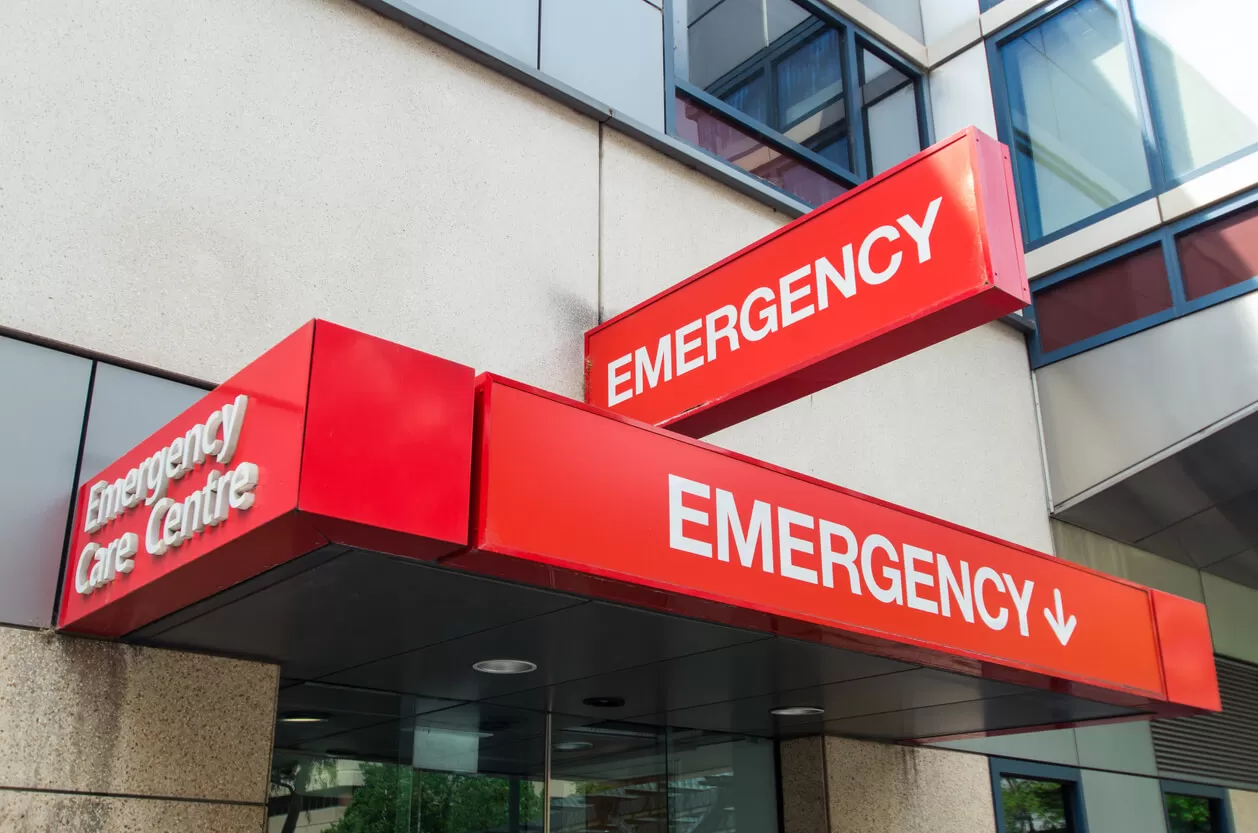Nobody plans for a medical emergency, but emergency room bills can be one of your biggest unexpected expenses. Costs can range from a few hundred dollars for minor issues to tens of thousands for serious conditions. The amount you’ll pay depends on your condition, health insurance, and the facility.
Understanding emergency room costs ahead of time helps you prepare financially and make smart decisions about your healthcare when you need it most.
How Much Is an Average Emergency Room Visit?
Recent healthcare data shows that emergency room costs depend on several factors, such as:
- Average Emergency Room Cost: Approximately $1,700 per visit, according to UnitedHealthcare’s 2023 data, which represents the median allowed amounts for network providers.
- Cost Comparison With Alternatives: Emergency room visits cost substantially more than other care options – up to $1,500 more than urgent care centers ($165) and significantly higher than primary care visits ($160) or virtual visits ($54 or less).
- Network vs. Out-of-Network Facilities: Freestanding emergency rooms or urgent centers may come with higher costs because they’re often out-of-network, even though they treat many of the same conditions as traditional ERs.
- Insurance Impact: Actual out-of-pocket costs depend on your specific insurance plan’s copayments, deductibles, and coinsurance structure, with costs potentially being much higher for out-of-network care.
- Wait Times and Convenience: While ERs are available 24/7, they typically involve up to 2 hours of waiting compared to 30 minutes or less at urgent care centers for non-emergency conditions.
Note: These costs represent the median allowed amounts for UnitedHealthcare network providers, and actual out-of-pocket expenses vary based on individual insurance coverage and benefits.
Key Factors Influencing Emergency Department Costs
Care Complexity and Medical Problem Severity
Emergency rooms use the Emergency Severity Index (ESI) system to classify a patient’s condition. This five-level scale helps determine the urgency of care needed and how much the visit may cost. More serious or life-threatening conditions require more tests, treatments, and staff time, with higher charges.
Most ER visits fall under level 4, which usually involves multiple diagnostic tests, such as blood work and X-rays, or treatments, such as IV fluids. That’s why even cases that seem minor can result in large bills.
It’s also important to know that your bill is based on your symptoms when you arrive, not your final diagnosis. For example, if you come in with chest pain or trouble breathing, the ER team must rule out serious conditions like a heart attack. Even if the issue turns out to be less dangerous, the visit may still be billed higher because of the urgent care you received at the start.
Facility Type and Timing
Hospital emergency departments typically charge less than freestanding emergency centers, which often bill higher for equivalent services. Additionally, overnight visits generally incur higher costs due to increased staffing requirements and operational expenses. Wait times may also be longer during peak hours, though this doesn’t typically affect billing.
Insurance Coverage Policy and Care Options
What you pay for an emergency room visit depends heavily on your health insurance plan. Insurance plans vary in their approach to emergency room visits:
- Copayment-Based Plans: These plans charge fixed amounts for a covered health care service, usually at the time you receive the service. Copay amounts can vary depending on the provider and service. For most plans, your copay does not apply toward your deductible.
- Deductible-Based Plans: Apply full charges toward your annual deductible until it is met.
- Hybrid Plans: Combine elements of both structures.
While federal law protects you during an emergency, your insurance plan still matters. Knowing the details can help you understand what you’ll need to pay.
How Do Emergency Departments Bill Patients?
Emergency room bills contain two primary components that arrive separately from different providers:
Facility Fees
Cover overhead expenses, including nursing staff, equipment, facility maintenance, and 24/7 operational requirements. Originally designed to compensate hospitals for the “stand-by” capacity required for emergency departments and inpatient services, these fees ensure hospitals can maintain round-the-clock emergency response capabilities where patient volumes can fluctuate unpredictably.
Professional Fees
Cover physician services, specialist consultations, nurse practitioners, physician assistants, and other provider fees. These vary based on the complexity of medical decision-making and procedures doctors and medical staff perform during your emergency visit.
Healthcare research says facility fees have increased by 531% since 2004, compared to a 132% growth in professional fees. These can add significant costs to routine services, with some outpatient evaluation and management services showing facility fees over $1,000. This is often double the provider’s fee to conduct the actual procedure.
This trend has grown as hospitals purchase private medical practices. As a result, they can add “facility fees” to bills, which are extra charges that didn’t apply when the same care was provided at independent offices.
Strategies to Minimize Emergency Care Expenses
Pre-Visit Assessment and Care Options
Before seeking emergency care, evaluate whether your medical emergency requires immediate attention or could be appropriately treated elsewhere:
- Urgent Care Centers: Handle non-life-threatening conditions like minor cuts, urinary tract infections, flu symptoms, and minor injuries at significantly lower costs. The average cost of an urgent care visit for a minor injury, like a sprain or a minor cut, is about $180.
- Convenience Care Clinics: Located in pharmacies and retail stores, these facilities treat basic illnesses and provide routine care with transparent pricing.
- Virtual Primary Care: Many health plans now cover telehealth consultations that can assess whether you need to visit the nearest emergency room or if alternative treatment is appropriate.
- Primary Care Physicians: When possible, contact your regular doctor first. They understand your health history and can guide appropriate care options.
During Your Emergency Room Visit
Even in emergencies, there are a few ways you can stay informed and help manage potential costs:
- Inquire about financial assistance programs available at the hospital
- If possible, ask about which tests are essential and which ones might be optional
- Ensure accurate insurance information is provided for proper billing
- Ask about estimated costs for non-emergency procedures
Post-Visit Bill Management
After receiving care:
- Review itemized bills carefully for accuracy and duplicate charges
- Contact billing departments to discuss payment plans or financial hardship programs
- Appeal insurance claim denials through your health plan’s established process
- Consider professional medical bill review services for complex cases
When Are High Emergency Room Visits Worth It?
Certain conditions require immediate emergency department evaluation regardless of financial considerations:
- Chest pain, trouble breathing, or signs of a heart attack
- Stroke symptoms (sudden weakness, speech changes, severe headache)
- Uncontrolled bleeding or major trauma from accidents
- Severe allergic reactions or suspected poisoning
- High fever with altered mental status
- Life-threatening conditions requiring immediate intervention
As mentioned, federal law protects your right to emergency care regardless of your ability to pay. The Emergency Medical Treatment & Labor Act (EMTALA) requires hospitals that accept Medicare to provide emergency medical screening and stabilizing treatment to anyone who needs it. This means you cannot be turned away from an emergency room due to lack of insurance or inability to pay during a true medical emergency.
Alternative Healthcare Options for Non-Emergency Situations
Research indicates that between 13.7% and 27.1% of emergency department visits could be appropriately managed at retail clinics or urgent care centers. This could save approximately $4.4 billion annually.
Urgent Care Centers vs. Emergency Rooms
Urgent care facilities provide an ideal middle ground between primary care and emergency departments for non-life-threatening conditions. These facilities are typically staffed by nurse practitioners, physician assistants, and doctors trained to handle:
- Minor injuries like sprains, cuts, and bruises
- Urinary tract infections and other common infections
- Flu symptoms and respiratory illness
- Basic diagnostic tests and X-rays
- Routine medications and prescriptions
Average urgent care visits cost significantly less than emergency room visits, making them cost-effective for appropriate conditions.
Convenience Care Clinics and Retail Health
Convenience care clinics in pharmacies and grocery stores handle basic healthcare needs with predictable pricing. These facilities can treat common illnesses, provide vaccinations, and offer basic health screenings.
Virtual Primary Care and Telehealth
Many insurance plans now cover virtual consultations that can guide treatment decisions and prevent unnecessary emergency visits. These services help patients understand their risk level and determine appropriate care options.
Factors Affecting Wait Times and Care Quality
When choosing between care options, consider these factors beyond cost:
- Emergency Departments: Always available for life-threatening conditions, but may have longer wait times for non-urgent cases. Staffed with emergency medicine specialists, nurses, and support staff trained in critical care.
- Urgent Care Centers: Short waits for non-emergency conditions, but limited hours. Staffed primarily by nurse practitioners and physician assistants with emergency medicine backup.
- Primary Care: Best continuity of care, but limited availability for urgent needs. Your regular physician understands your health history and risk factors.
When You Need Emergency Care, Choose Reliant Emergency Room
Emergency room visits can be expensive. Knowing how billing works and what your insurance covers helps you make smart decisions about your care. Many health issues can be treated more affordably at urgent care centers or through virtual care. But for real medical emergencies, getting immediate care at a professional emergency room is crucial, no matter the cost.
When facing a genuine medical emergency in Corpus Christi, Texas, Reliant Emergency Room provides the highest quality emergency care in a state-of-the-art environment. Our highly trained and experienced personnel deliver expeditious care 24 hours a day, 7 days a week, at our convenient location. The goal is to match the right level of care to your specific health needs. When emergency care is needed, Reliant ER is committed to providing exceptional service when you need it most.
Don’t wait when every second counts. Call (361) 257-1478 now for immediate assistance, or visit us at 3910 Saratoga Blvd, Corpus Christi, TX 78415.







